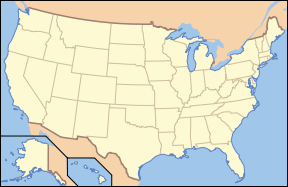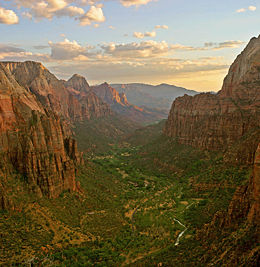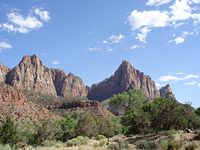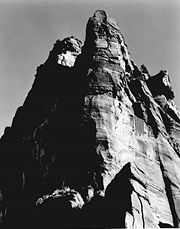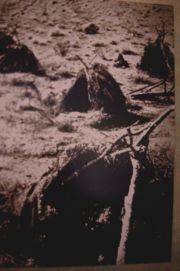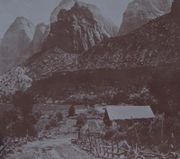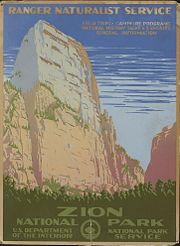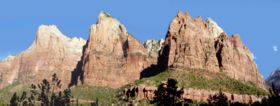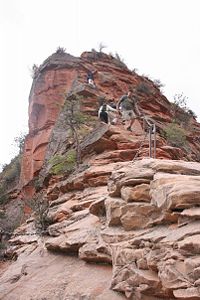Zion National Park
2008/9 Schools Wikipedia Selection. Related subjects: North American Geography
| Zion National Park | |
|---|---|
| IUCN Category II ( National Park) | |
| Location | Washington, Kane, and Iron counties, Utah, USA |
| Nearest city | Springdale, Utah(west), Orderville, Utah (east) and Cedar City, Utah near Kolob Canyons entrance. |
| Coordinates | |
| Area | 146,598 acres ({{ Convert}} no longer accepts sqkm as code. Please use km2 instead. Please refer to {{convert}}'s talk page for the reasoning behind this. Sorry for any inconvenience.), 143,035.07 acres ({{ Convert}} no longer accepts sqkm as code. Please use km2 instead. Please refer to {{convert}}'s talk page for the reasoning behind this. Sorry for any inconvenience.) federal |
| Established | July 31, 1909 |
| Visitors | 2,567,350 (in 2006) |
| Governing body | National Park Service |
Zion National Park is a United States National Park located in the Southwestern United States, near Springdale, Utah. A prominent feature of the 229- square-mile (593 km²) park is Zion Canyon, 15 miles (24 km) long and up to half a mile (800 m) deep, cut through the reddish and tan-colored Navajo Sandstone by the North Fork of the Virgin River. Located at the junction of the Colorado Plateau, Great Basin, and Mojave Desert regions, this unique geography and variety of life zones allow for unusual plant and animal diversity. A total of 289 bird species, 75 mammals (including 19 species of bat), 32 reptiles and numerous plant species inhabit the park's four life zones: desert, riparian, woodland, and coniferous forest. Notable megafauna include Mountain Lions, Mule Deer and Golden Eagles, along with reintroduced California Condors and Bighorn Sheep. Common plant species include Cottonwood, Cactus, Datura, Juniper, Pine, Boxelder, Sagebrush, yucca , and various willows.
Human habitation of the area started about 8,000 years ago with small family groups of Native Americans; the semi-nomadic Basketmaker Anasazi (300 CE) stem from one of these groups. In turn, the Virgin Anasazi culture (500 CE) developed as the Basketmakers settled in permanent communities. A different group, the Parowan Fremont, lived in the area as well. Both groups moved away by 1300 and were replaced by the Parrusits and several other Southern Paiute subtribes. The canyon was discovered by Mormons in 1858 and was settled by that same group in the early 1860s. Mukuntuweap National Monument was established in 1909 to protect the canyon, and by 1919 the monument was expanded to become Zion National Park ( Zion is an ancient Hebrew word meaning a place of refuge or sanctuary). The Kolob section was proclaimed a separate Zion National Monument in 1937, but was incorporated into the park in 1956.
The geology of the Zion and Kolob canyons area includes nine formations that together represent 150 million years of mostly Mesozoic-aged sedimentation. At various periods in that time, warm, shallow seas, streams, ponds and lakes, vast deserts and dry near-shore environments covered the area. Uplift associated with the creation of the Colorado Plateaus lifted the region 10,000 feet (3000 m) starting 13 million years ago.
Geography and climate
The park is located in southwestern Utah in Washington, Iron, and Kane counties. Geomorphically, it is located on the Markagunt and Kolob plateaus, at the intersection of three North American geographic provinces: The Colorado Plateaus, the Great Basin, and the Mojave Desert. The northern part of the park is known as the Kolob Canyons section and is accessible from Interstate 15, exit 40.
The 8,726 foot (2660 m) summit of Horse Ranch Mountain ( photo) is the highest point in the park; the lowest point is the 3,666 foot (1117 m) elevation of Coal Pits Wash, creating a relief of about 5,100 feet (1500 m).
Streams in the area follow rectangular paths because they follow jointing planes in the rocks. The headwaters of the Virgin River are at about 9,000 feet (2700 m) and the river empties into Lake Mead 200 miles (320 km) southeast after flowing 8,000 feet (2400 m) downward. This gives the Virgin a stream gradient that ranges from 50 to 80 feet per mile (0.9–1.5%)—one of the steepest stream gradients in North America.
The road into Zion Canyon is 6 miles (9.7 km) long, ending at the Temple of Sinawava ("Sinawava" refers to the Coyote God of the Paiute Indians). At the Temple, the canyon narrows and a foot-trail continues to the mouth of the Zion Narrows, a spectacular gorge with walls 40–100 feet (12–30 meters) wide and 1000 feet (300 m) tall. The Zion Canyon road is served by a free shuttle bus from early April to late October and by private vehicles the other months of the year. Other roads in Zion are open to private vehicles year-round.
Other areas of the park also offer outstanding scenery. The east side of the park is served by the Zion-Mount Carmel Highway which passes through the Zion-Mount Carmel Tunnel and ends at Mt. Carmel Junction. On the east side of the park notable park features include Checkerboard Mesa and the East Temple and one of the more popular hikes, the Canyon Overlook Trail.
West of Zion Canyon, the Kolob Terrace area features The Subway, a famous slot canyon hike, and Lava Point, with a spectacular view of the entire area. The Kolob Canyons section, further west near Cedar City, features one of the world's longest arches, Kolob Arch.
Spring weather is unpredictable, with stormy, wet days being common, mixed with occasional warm, sunny weather. Precipitation is heaviest in March. Spring wildflowers bloom from April through June, peaking in May. Fall days are usually clear and mild; nights are often cool. Summer days are hot (95 ° F to 110 °F; 35 ° C to 43 °C), but overnight lows are usually comfortable (65 °F to 70 °F; 18 °C to 21 °C). Afternoon thunderstorms are common from mid-July through mid-September. Storms may produce waterfalls as well as flash floods. Autumn tree-colour displays begin in September in the high country; inside Zion Canyon, autumn colors usually peak in late October. Winter in Zion Canyon is fairly mild. Winter storms bring rain or light snow to Zion Canyon and heavier snow to the higher elevations. Clear days may become quite warm, reaching 60 °F (16 °C); nights are often 20 °F (−7 °C) to 40 °F (4 °C) . Winter storms can last several days and make roads icy. Zion roads are plowed, except the Kolob Terrace Road and the Kolob Canyons Road, which are closed when covered with snow. Winter driving conditions persist from November through March.
Notable geographical features of the park
- National Park Service Map (shows feature locations)
- Virgin River Narrows
- Emerald Pools ( photo) ( photo)
- Hidden Canyon ( photo) ( photo) ( photo) ( photo)
- Angels Landing ( photo) ( photo) ( photo) ( photo)
- The Great White Throne ( photo)
- Checkerboard Mesa ( photo)
- The Three Patriarchs (photo)
- Kolob Arch, a remote cliff wall arch
Human history
Archaeologists have divided the long span of Zion's human history into three cultural periods, each characterized by distinctive technological and social adaptations.
Archaic period
The first human use in the region dates to 8,000 years ago when family groups camped where they could hunt or collect plants and seeds. About 2,000 years ago, some groups began growing maize and other crops, leading to an increasingly sedentary lifestyle. Later groups in this period built permanent villages (called pueblos). Archaeologists call this the Archaic period and it lasted until about 500 CE. Baskets, cordage nets, and yucca fibre sandals have been found and dated to this period. The Archaic toolkits included flaked stone knives, drills, and stemmed dart points. The dart points were hafted to wooden shafts and propelled by throwing devices called atlatls.
By 300 CE some of the archaic groups developed into an early branch of seminomadic Anasazi, the Basketmakers. Basketmaker sites have grass- or stone-lined storage cists and shallow, partially underground dwellings called pithouses. They were hunters and gatherers who supplemented their diet with limited agriculture. Locally collected pine nuts were important for food and trade.
Protohistoric period
The Parrusits and several other Southern Paiute subtribes lived in the Virgin River Valley south of Zion Canyon for hundreds of years following the departure of the Anasazi and Fremont Indians around 1300 CE. Tradition and archaeological evidence holds that they are a Numic-speaking cousin of the Virgin Anasazi. Parrusits seasonally migrated up and down the valley in search of wild seeds and nuts in what is called the Neo-Archaic period. Some farming and hunting supplemented their diet.
Evidence suggests the Parrusits had great reverence for the large monoliths and turbulent waters in Zion Canyon. They believed the monoliths were responsible for the streams and springs they depended upon by communicating with the rocks, animals, water, and plants that make their home there. Modern bands of Southern Paiute still visit sites within the park to perform rituals and collect plants.
Historic period
Early exploration
The Historic period begins in the late 18th century, with the exploration and settlement of southern Utah by Euro-Americans. Padres Silvestre Vélez de Escalante and Francisco Atanasio Domínguez passed near what is now the Kolob Canyons Visitor Centre on October 13, 1776, becoming the first white men known to visit the area. In 1826, trapper and trader Jedediah Smith led 16 men to explore the area in a quest to find a route to California. These and other explorations by traders from New Mexico blazed the Old Spanish Trail, which followed the Virgin River for a portion of its length. Captain John C. Fremont wrote about his 1844 journeys in the region.
Mormon pioneers and the Powell expedition
In the 1850s, Mormon farmers from the Salt Lake area became the first white people to settle the Virgin River region. In 1851, the Parowan and Cedar City, Utah areas were settled by Mormons who used the Kolob Canyons area for timber, and for grazing cattle, sheep, and horses. They prospected for mineral deposits, and diverted Kolob water to irrigate crops in the valley below. Mormon settlers named the area Kolob - in Mormon scripture, the star nearest the residence of God.
In 1858, they had expanded 30 miles (48 km) south to the lower Virgin River. That year, a Southern Paiute guide led young Mormon missionary and interpreter Nephi Johnson into the upper Virgin River area and Zion Canyon. Johnson wrote a favorable report about the agricultural potential of the upper Virgin River basin, and returned later that year to found the town of Virgin. More settlers arrived in 1860 and 1861 and settled the towns of Rockville and Springdale. Catastrophic flooding by the river (especially in the Great Flood of 1861–1862), little arable land, and poor soils made agriculture in the upper Virgin River a risky venture.
In 1861 or 1862, Joseph Black made the arduous journey to Zion Canyon and was very impressed by its beauty. His stories about the Canyon were at first seen as exaggerated, prompting his neighbors to call the Canyon "Joseph's Glory". The floor of Zion Canyon was settled in 1863 by Isaac Behunin, who farmed corn, tobacco, and fruit trees. The Behunin family lived in Zion canyon near the site of today's Zion Lodge during the summer, and wintered in Springdale. Isaac Behunin is credited with naming Zion, a reference to a place of peace mentioned in the Bible.
Two more families settled Zion canyon in the next couple of years, bringing with them cattle and other domesticated animals. The canyon floor was farmed until Zion became a Monument in 1909.
The Powell Geographic Expedition entered the area in 1869 after their first trip through the Grand Canyon. Powell returned in September 1872 and descended the East Fork of the Virgin River (Parunuweap Canyon) to the town of Shunesberg. He may have made the climb up to Zion Canyon, and named it Mukuntuweap under the impression that that was the Paiute name. In the same year, Geologist Grove Karl Gilbert, working with the Wheeler Survey, descended the North Fork of the Virgin River from Navajo Lake to Zion Canyon, making the first recorded descent of "The Zion Narrows". It is likely that he named this remarkable section of canyon in the process.
Powell Survey photographers, Jack Hillers and James Fennemore, first visited the Zion Canyon and Kolob Plateau region in the spring of 1872. Hillers returned in April of 1873 to add more photographs to the "Virgin River Series" of photographs and stereographs. Hillers described wading the canyon for 4 days and nearly freezing to death to take his photographs. Geologist Clarence Dutton later mapped the region and artist William H. Holmes documented the scenery.
Protection and tourism
Paintings of the canyon by Frederick S. Dellenbaugh were exhibited at the St. Louis World's Fair in 1904, followed by a glowing article in Scribner's Magazine the next year. That, along with previously created photographs, paintings, and reports, led to U.S. President William Howard Taft's proclamation creating Mukuntuweap National Monument on July 31, 1909. In 1917, the acting director of the newly created National Park Service visited the canyon and proposed changing its name Zion from the locally unpopular Mukuntuweap. That occurred the following year. The United States Congress added more land and established Zion National Park on November 19, 1919. A separate Zion National Monument, the Kolob Canyons area, was proclaimed on January 22, 1937, and was incorporated into the park on July 11, 1956.
Travel to the area before it was a national park was rare due to its remote location, lack of accommodations, and the absence of real roads in southern Utah. Old wagon roads were upgraded to the first automobile roads starting about 1910, and the road into Zion Canyon was built in 1917, to as far as The Grotto.
By the summer of 1917, touring cars could reach Zion Canyon, and the Wylie Camp was established - a tent camp providing the first visitor lodging in Zion Canyon. The Utah Parks Company, a subsidiary of the Union Pacific Railroad, acquired the Wylie Camp in 1923, and offered ten-day rail/bus tours to Zion, Bryce, Kaibab, and the North Rim of the Grand Canyon. The Zion Lodge complex was built in 1925 at the site of the Wylie tent camp. Architect Gilbert Stanley Underwood designed Zion Lodge in the "Rustic Style" and the Utah Parks Company funded the construction. In 1968, the main lodge building was destroyed by fire but was quickly rebuilt. The detached Western Cabins ( photo) survived and were added to the National Register of Historic Places.
Work on the Zion-Mount Carmel Highway started in 1927 to provide reliable access between Springdale and the east side of the park. The road opened in 1930 and park visitation and travel in the area greatly increased. The most famous feature of the highway is the 1.1-mile (1.8-km) Zion-Mount Carmel Tunnel, which has six large windows cut through the massive sandstone cliff. On the south side of the tunnel, switchbacks take motorists from the tunnel to the floor of Zion Canyon. On the east side the Zion-Mt. Carmel Highway terminates at Mt. Carmel Junction and Highway 89, allowing visitors to travel by car to other national parks, including Bryce Canyon and the Grand Canyon.
In 1896, local rancher John Winder improved the Native American footpath up Echo Canyon so he could travel on horseback up to the East Rim, and hence to Long Valley. This trail was improved again about 1925 and became the East Rim Trail. Other trails were built in 1925 including the West Rim Trail and the Lady Mountain Trail. The auto road was extended to the Temple of Sinawava, and a trail built from there one mile (1.6 km) to the start of the Narrows. The next year saw construction of the Angels Landing Trail, and two suspension bridges were built over the Virgin River. The Hidden Canyon trail was built in 1928. The West Rim and East Rim Trail were built for horse-back riding visitors, and were blasted out of the sandstone in many places.
The original ranger cabin was built at The Grotto in the 1920s. A real visitor center was first built in the 1950s, facing the Temples and Towers of the Virgin. Park facilities were redesigned in 2000, with the visitor centre converted to a human-history museum ( photo) and visitor centre functions moved to a new solar powered facility adjacent to the south entrance.
Zion Canyon Scenic Drive provides access to Zion Canyon. Traffic congestion in the narrow canyon was recognized as a major problem in the 1990s and a public transportation system using propane-powered shuttle buses was instituted in the year 2000. From April through October, the scenic drive in Zion Canyon is closed to private vehicles, and visitors ride the frequent shuttle buses. The new plan restored natural quiet to the canyon.
On April 12, 1995, heavy rains triggered a landslide that blocked the Virgin River in Zion Canyon. Over a period of two hours, the river carved away 590 feet (190 m) of the only exit road from the canyon, trapping 450 guests and employees in the Zion Lodge. A one-lane temporary road was constructed within 24 hours to allow evacuation of the Lodge. A more stable, albeit temporary, road was completed on May 25, 1995 to allow summer visitors to access the park. This road was replaced with a permanent road during the first half of 1996.
The Zion-Mount Carmel Highway can be traveled year-round. Access for over-sized vehicles requires a special permit, and is limited to daytime hours, as traffic through the tunnel must be one way to accommodate large vehicles.
The 5 mile (8 km) Kolob Canyons Road was built in the mid-1960s to provide a scenic drive and access to the Kolob Canyons section of the park. This road often closes in the winter.
Geology
The nine known exposed formations visible in Zion National Park are part of a super-sequence of rock units called the Grand Staircase; they represent about 150 million years of mostly Mesozoic-aged sedimentation in that part of North America. The formations exposed in the Zion area were deposited as sediment in very different environments:
- The warm, shallow (sometimes advancing or retreating) sea of the Kaibab and Moenkopi formations;
- Streams, ponds, and lakes of the Chinle, Moenave, and Kayenta formations;
- The vast desert of the Navajo and Temple Cap formations; and
- The dry near-shore environment of the Carmel Formation.
Uplift affected the entire region, known as the Colorado Plateaus, by slowly raising these formations more than 10,000 feet (3,000 m) higher than where they were deposited. This steepened the stream gradient of the ancestral Virgin and other rivers on the plateau.
The fast-moving streams took advantage of uplift-created joints in the rocks to remove all Cenozoic-aged formations and cut gorges into the plateaus. Zion Canyon was cut by the North Fork of the Virgin River in this way. During the later part of this process, lava flows and cinder cones covered parts of the area.
High water volume in wet seasons does most of the downcutting in the main canyon and carries much of the 3 million tons of rock and sediment that the Virgin River transports yearly. The Virgin cuts away its canyon faster than its tributaries can cut away their own streambeds, so tributaries end in waterfalls from hanging valleys where they meet the Virgin. The valley between the peaks of the Twin Brothers is a notable example of a hanging valley in the canyon.
Biology
The Great Basin, Mojave Desert, and Colorado Plateau converge at Zion and the Kolob canyons. This, along with the varied topography of canyon- mesa country, differing soil types, and uneven water availability, provides diverse habitat for the equally diverse mix of plants and animals that live in the area. In 1999, biologists counted 289 bird species in the park. Seventy-five mammal and 32 reptile and amphibian species are also found. These organisms make their home in one or more of four life zones found in the Park:
Desert conditions persist on canyon bottoms and rocky ledges away from perennial streams. Sagebrush, Prickly pear Cactus, and Rabbitbrush, along with Sacred Datura and Indian Paintbrush are common. Utah Penstemon and Golden Aster can also be found. Milkvetch and Prince's Plume are found in pockets of selenium-rich soils. Common daytime animals include Rock Squirrels, Pinyon Jays and Whiptail and Collared lizards. ( photo) Desert Cottontails, Jackrabbits, and Merriam's Kangaroo Rats come out at night. Cougars, Coyotes, Gray Foxes, and Ringtails are the top predators.
Cooler conditions persist at mid-elevation slopes, between 3900 to 5500 feet (1190 to 1680 m). Stunted forests of pinyon pine and Juniper coexist here with manzanita shrubs, cliffrose, serviceberry, Scrub Oak, and yucca.
Stands of Ponderosa Pine, Gambel Oak, manzanita and aspen populate the mesas and cliffs above 6000 feet (1830 m).
Golden Eagles, Red-tailed Hawks, Peregrine Falcons, and White-throated Swifts can be seen in the area. California Condors and Bighorn Sheep were introduced in the 1990s. Nineteen species of bat also live in the area.
Boxelder, Fremont Cottonwood, maple, and willow dominate riparian plant communities. Animals such as the Bank Beaver, Flannel-mouth Suckers, Gnatcatchers, Dippers, Canyon Wrens, the Virgin Spinedace, and Water Striders all make their homes in the riparian zones. Mule Deer browse on vegetation throughout the park.
Activities
For many, the highlight of Zion is a trip up the main canyon to the Temple of Sinawava, via the park-run propane-powered free shuttle buses (operating April 1 to October 31) or driving in their own vehicles the rest of the year. Spectacular, colorful sandstone cliffs soar into the sky above a flat-bottomed, forested valley floor.
Driving through the east side of Zion to U.S. Route 89 allows access north to Bryce Canyon National Park or south to the north rim of the Grand Canyon. Due to the narrowness of the Zion-Mount Carmel Tunnel, RVs and buses must obtain a special pass and run through the tunnel during limited hours.
The more primitive sections of Zion include the Kolob Terrace and the Kolob Canyons. The Grotto in Zion Canyon and the viewpoint at the end of Kolob Canyons Road have the only designated picnic sites.
More than 150 miles (240 km) of maintained trails provide access to the roadless interior. Seven popular trails with round-trip times of half an hour (Weeping Rock) to 4 hours (Angels Landing) are found in Zion Canyon. Two popular trails, Taylor Creek (4 hours round trip) and Kolob Arch (9 hours round trip) are in the Kolob Canyons section of the park (near Cedar City). Hiking up into The Narrows from the Temple of Sinawava is a popular summertime diversion. Orderville Canyon, a narrower slot canyon, is also a favorite. Heartier souls can backpack down The Narrows from the top in two days, or hike down in one long day (12 hours). Other popular backpack trips include the West Rim Trail and LaVerkin Creek/Kolob Arch.
Zion is a centre for Rock climbing, with short walls like Touchstone, Moonlight Buttress, Spaceshot and Prodigal Son being very popular. There are many short free climbs, and a large number of hard, long aid climbs. Rockclimbing does not require a permit, though any anticipated bivy on a wall does. Certain areas are closed for raptor nesting in the spring.
Zion is the USA's most concentrated centre for canyoneering. Popular routes like Pine Creek and Mystery Canyon were first descended in the 1950s and 1960s, with the last of the big drainages (Heaps) descended in 1982. Zion has a concentration of about 50 technical canyons, characterized by downclimbing and rappels in beautiful sandstone canyons. The most difficult canyons have long sections of entrenched narrows, with keeper potholes that require technical gear and specialized techniques to escape.
Lodging in the park is available at Zion Lodge, located halfway through Zion Canyon. Zion Lodge is open year-round and has motel units, cabins, a restaurant, café, and gift shop but rooms fill up fast. Three campgrounds are available; South and Watchman at the far south side of the park, and a primitive site at Lava Point in the middle of the park off Kolob Terrace Road. Watchman is the only campground in the park that takes reservations and Lava Point has only primitive facilities and is usually open from May to October. Camping in the backcountry requires permits.
Guided horseback riding trips, nature walks, and evening programs are available from late March to early November. The Junior Ranger Program for ages 6 to 12 is active from Memorial Day to Labor Day at the Zion Nature Centre.
Rangers at the Zion Canyon Visitor Center and the smaller Kolob Canyons Visitor Center can help visitors plan their stay. A bookstore attached to the Zion Canyon Visitor Centre, run by the Zion Natural History Association, offers books, maps, and souvenirs for sale, with proceeds benefiting the park. The Association also runs the Zion Human History Museum.
Zion Canyon IMAX in nearby Springdale, features many interesting documentaries about the natural history of Zion Canyon and the American Southwest
Adjacent to the park on the south, is the town of Springdale, Utah which offers services such as lodging, food, and entertainment. There is also lodging, food and entertainment offered on the east side of the park along the Zion-Mount Carmel Highway and in Mt Carmel Junction.
